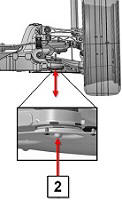Tesla Model X: Alignment Check
- Raise the alignment platform until it is clear of all 4 rack locks.
- Lower the alignment platform onto the rack locks and ensure that it is level.
- Secure all 4 alignment optical targets.
- Perform the rolling compensation.
- Remove the pins from the slip plates and turn plates.
- Air suspension only: Check the ride height:
- If the fasteners that secure a subframe, ride height
sensor, ride height sensor bracket, front upper control
arm, or rear camber link have been loosened or removed:
- Select Normal in the Toolbox "Air Suspension Leveling" panel.
- Place the measuring tool on the platform, then
measure the distance from the platform to the bolt
head (front corners) or tip of the bolt (rear
corners).

Front Suspension (rearmost subframe bolt, rear view, left side) Rear Suspension (front subframe bolt, front view, left side) 

1 Measure to center of bolt head 2 Measure to center of bolt end tip - Record the measured ride heights for each corner.
- In Toolbox, refer to the "Ride Height" panel.
Subtract the ride height shown by Toolbox from the
measured ride height for each corner. Refer to the
example below.
Note: If the Toolbox ride height is a negative number, add it to the physical measurement. If the Toolbox ride height is a positive number, subtract it from the physical measurement.
Table 1. Example Only Left Front Right Front Left Rear Right Rear Physical measurement 213 208 140 143 Toolbox ride height -2 +3 +1 -4 Total (physical measurement - Toolbox ride height) 215 205 139 147 - Compare the total heights of each corner to the
ride height specifications: General
Information > Technical Data > Wheel
Alignment.
Note: The specification shown is an example. Refer to General Information > Technical Data > Wheel Alignment for the proper specifications. Note: The specification shown is an example. Refer to General Information > Technical Data > Wheel Alignment for the proper specifications.Left Front Right Front Left Rear Right Rear Total from previous step 215 205 139 147 Specification 213.5 +/- 5 213.5 +/- 5 144 +/- 5 144 +/- 5 Result Pass Fail Pass Pass - If the total of any value is outside of the specifications, perform a ride height calibration (refer to procedure).
Note: The ride height calibration is not included in the four wheel alignment check correction code. Add the ride height calibration correction code separately.
- If none of the above fasteners have been loosened or
removed:
- In Toolbox, select Views > Suspension > Air Suspension Leveling, then run the Cycle Heights High > Normal routine.
- In Toolbox, select Views > Suspension > Ride Height.
- Check that each level is between -5 mm and +5 mm.
- If any level is not between -5 mm and +5 mm, run the Cycle Heights High > Normal routine again.
- If any level is not between -5 mm and +5 mm, run the Cycle Heights High > Normal routine again.
- If the fasteners that secure a subframe, ride height
sensor, ride height sensor bracket, front upper control
arm, or rear camber link have been loosened or removed:
- Install the brake pedal depressor.
- Perform a caster sweep without sitting inside or leaning on the vehicle.
- Turn the steering wheel so that the steering wheel angle displayed on the touchscreen is 0.0 degrees, then install the steering wheel holder.
Note: If the vehicle fails the alignment check, perform a full alignment (refer to procedure) and add the appropriate correction code for "Four Wheel Alignment - Adjust Only":
- Air Suspension:31002100
- Coil Suspension:31002200
- Transfer the PDF of the alignment results from the alignment machine and attach it to the repair order.
- Remove the brake pedal depressor.
- Reinstall all slip plate pins and turn plate pins. Tip: Install the forward slip plate pins before installing the rearward slip plate pins.
- Remove all 4 alignment optical targets.
- Enter the vehicle.
- Press the brake pedal and shift into Park.
- Remove the wheel chocks.
- Remove the vehicle from the alignment rack.
